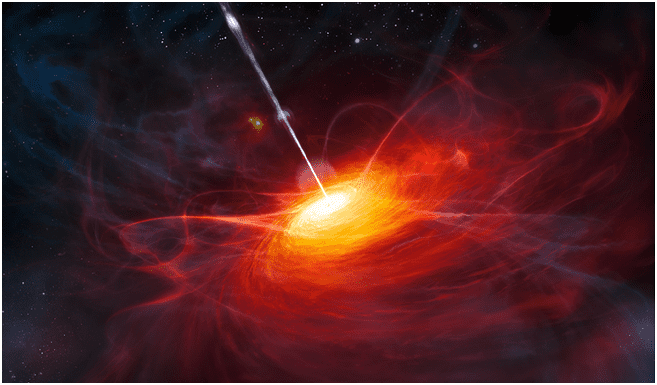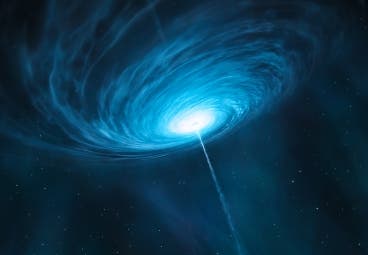Determining when stars first started to form through out the early Universe is a matter of great importance for astronomers and astrophysicists looking to understand how the cosmos evolved from its incipient point of origin. Recently, researchers at MIT who have been studying the most distant quasar observed so far found no discernible trace of heavy elements, such as carbon and oxygen. Their findings suggest that stars had yet to be born 750 million years after the Big Bang.
The elements are only formed by stars – essentially we all come from stars. If these basic building blocks aren’t visible then the quasar dates to an era nearing that of the universe’s first stars.
After the Big Bang massive amounts of matter and energy were flung, leading to the expansion of the early Universe. In the minutes following the explosion, protons and neutrons collided in nuclear fusion reactions to form hydrogen and helium. Once the Universe cooled, fusion ceased along with the generation of these primordial elements. It would be until the first stars appeared that heavy elements such as oxygen or carbon could be synthesized.
Lack of these elements in observations suggests that stars hadn’t been formed during that phase of the Universe. So far, the farthest astronomers have gone to study the light of distant objects was 11 billion years – the Universe is 13.7 billion years old, and each time heavy elements were found. Last year scientists discovered the earliest quasar found so far, which provided a snapshot of our universe during its infancy, a mere 750 million years after the initial explosion that created the universe.
“The first stars will form in different spots in the universe … it’s not like they flashed on at the same time,” says Robert Simcoe, an associate professor of physics at MIT. “But this is the time that it starts getting interesting.”
“[The astrophysics community] sort of hit this wall,” says Simcoe, an astrophysicist at MIT’s Kavli Institute for Astrophysics and Space Research. “When this [quasar] was discovered, we could sort of leapfrog further back in time and make a measurement that was substantially earlier.”
Before stars shone bright

An artist’s rendering of how the most distant quasar found to date would have appeared just 770 million years after the Big Bang (credit: European Southern Observatory/M. Kornmesser)
Recently MIT astronomers pointed the Magellan Telescope, a massive ground-based telescope in Chile, which they fitted with a carefully designed spectrometer, towards the quasar to study its light spectrum. Each element gives of a pattern, based on how it characteristically absorbs light. Based on this, the scientists found evidence of hydrogen, but no oxygen, silicon, iron or magnesium in the light data.
“[The birth of the first stars] is one of these important moments in the history of the universe,” Simcoe says. “It went from looking like the early universe, which was just gas and dark matter, to looking like it does today, where there are stars and galaxies … it’s the point when the universe started to resemble what it looks like today. And it’s sort of amazing how early that happens. It didn’t take long.”
Other scientists, like John O’Meara, an associate professor of physics at St. Michael’s College in Vermont, believe that more observations of distant quasars is needed in order to confirm the findings.
“Prior to this result, we have not seen regions of the universe this old and devoid of heavy elements, so there was a missing link in our understanding of how the elemental content of the universe has evolved with time,” O’Meara adds. “[This] discovery possibly provides such a rare environment where the universe had yet to form stars.”
Results were published in the journal Nature.
source: MIT










